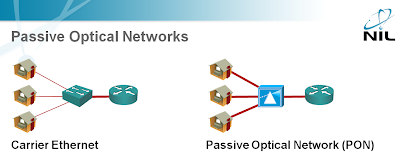Passive Optical Networks
When I’ve first heard about Passive Optical Networks, this blast from the past almost made my head explode. Imagine this: you’re replacing obsolete copper cabling with fiber and decide to create shared media access network similar to the widely hated cable networks.

The only benefit of PON networks that I can see is that it only needs passive equipment at the concentration point. My list of drawbacks is huge, ranging from security concerns to service evolution. What’s your opinion? Would you like to correct my bearing?

In my country (Bulgaria), there is ISP that offer PON from about 1 year ago (www.pon.bg) . I thing it is not a bad idea, because you can get internet, digital TV and phone over this network. The price that is offered is better than if you pay separatelly for phone, tv and intenet. I think this is an advantige!
BR,
Tihomir
PON is not a perfect solution, but it has big advantage - the cost, and it provides more bandwidth than copper. yeah, it would be perfect for ISPs to build and support switched ethernet as a broadband access but again THE COST ;]
cheers
Peter
The primary use of PON technology is in delivery of residential (3-play) services (plus some RF and POTS), and it was designed with this in mind. There are a few flavors of PON around (APON / BPON / EPON / GPON / 10-GE PON), with their individual positives and negatives. I also see some passive CWDM solutions being pitched as "WDM PON", while it actually isn't.
If considering PON as a means of delivery of business-grade services, the key drawback is the lack of ability to perform the OTDR to find the location of the fibre break, when it happens - because a single optical line can be split up to 8 by 8 ways (think a single trunk with 8 branches, each of which has 8 leaves, giving you up to 64 subscribers (ONTs) connected to a single OLT port). Other than that, this technology is as good as any other out there. The company where I'm working now has fairly significant deployments of PON infrastructure as the means to deliver some business-grade Carrier Ethernet services, and they're doing just fine.
Regarding service evolution - if you consider the developments that have happened in PON to date, you'll see that the service speeds were steadily growing, with 100Mbps per ONT being pretty much standard and GigE options being readily available with 10G on the way.
Not sure what are your concerns with the security. ONTs listen only for their own traffic (identified by MAC), while upstream transmission is "TDM'd" (and there's no direct communications between the ONTs).
-- Dmitri
-- Dmitri
Beyond the cost advantages and new revenue opportunities, the fact that you can do data + RF over PON is great, giving you a cable-like TV experience (no box required for analog) with the flexiblity of 2.4Gbps shared by 32 subscribers. It also means if you have a satellite service you could potentially also provide RF feeds to those boxes, removing the need to provide new terminals to clients.
Now, how secure that system is, is another question.
Also, I doubt the Service Providers would be satisfied with 1:32 ratio; they’d probably push it as far as it goes.